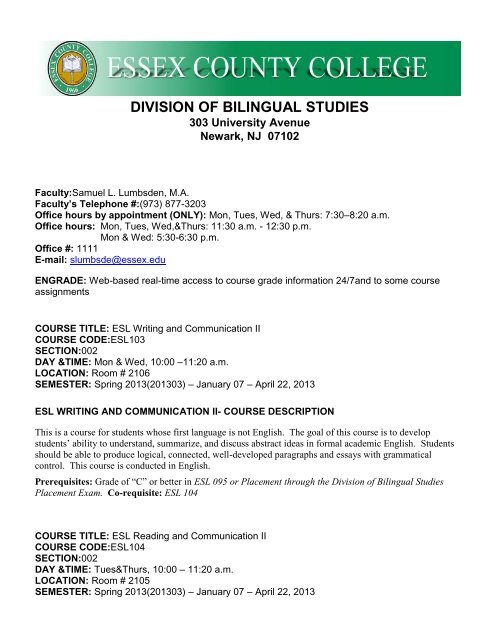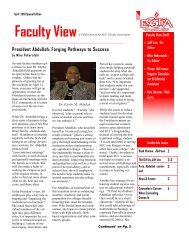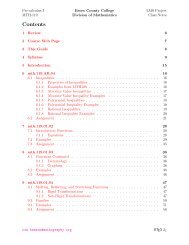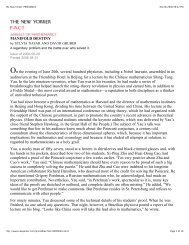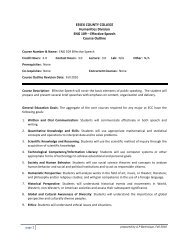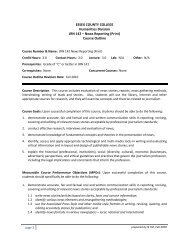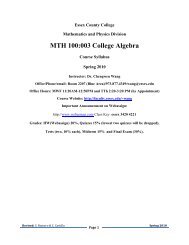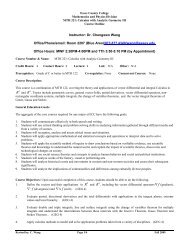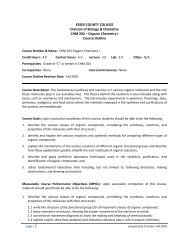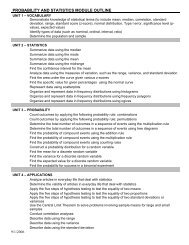Syllabus - Essex County College Faculty Web Server
Syllabus - Essex County College Faculty Web Server
Syllabus - Essex County College Faculty Web Server
Create successful ePaper yourself
Turn your PDF publications into a flip-book with our unique Google optimized e-Paper software.
DIVISION OF BILINGUAL STUDIES303 University AvenueNewark, NJ 07102<strong>Faculty</strong>:Samuel L. Lumbsden, M.A.<strong>Faculty</strong>’s Telephone #:(973) 877-3203Office hours by appointment (ONLY): Mon, Tues, Wed, & Thurs: 7:30–8:20 a.m.Office hours: Mon, Tues, Wed,&Thurs: 11:30 a.m. - 12:30 p.m.Mon & Wed: 5:30-6:30 p.m.Office #: 1111E-mail: slumbsde@essex.eduENGRADE: <strong>Web</strong>-based real-time access to course grade information 24/7and to some courseassignmentsCOURSE TITLE: ESL Writing and Communication IICOURSE CODE:ESL103SECTION:002DAY &TIME: Mon & Wed, 10:00 –11:20 a.m.LOCATION: Room # 2106SEMESTER: Spring 2013(201303) – January 07 – April 22, 2013ESL WRITING AND COMMUNICATION II- COURSE DESCRIPTIONThis is a course for students whose first language is not English. The goal of this course is to developstudents’ ability to understand, summarize, and discuss abstract ideas in formal academic English. Studentsshould be able to produce logical, connected, well-developed paragraphs and essays with grammaticalcontrol. This course is conducted in English.Prerequisites: Grade of “C” or better in ESL 095 or Placement through the Division of Bilingual StudiesPlacement Exam. Co-requisite: ESL 104COURSE TITLE: ESL Reading and Communication IICOURSE CODE:ESL104SECTION:002DAY &TIME: Tues&Thurs, 10:00 – 11:20 a.m.LOCATION: Room # 2105SEMESTER: Spring 2013(201303) – January 07 – April 22, 2013
C o u r s e S y l l a b i & O u t l i n e P a g e | 2E S L 1 0 3 / 1 0 4P r o f . L u m b s d e nESL READING AND COMMUNICATION II - COURSE DESCRIPTIONThis is a course for students whose first language is not English. Through the readingof authentic works of fiction and nonfiction, students will increase their command ofAmerican English vocabulary, syntax, writing and speaking styles. In addition,students will be introduced to relevant aspects of American culture, history, andsociety. This course is conducted in English.Prerequisites: Grade of “C” or better in ESL 095 or Placement through the Division ofBilingual Studies Placement Exam. Co-requisite: ESL 103COURSE GOAL (ESL103)1. Demonstrate proficiency in expository writing; to the extent possible, to include writing expositorypieces with a clear focus, sufficient support to that focus, logical development of ideas, and introductionsand conclusions.MEASURABLE COURSE PERFORMANCE OBJECTIVES (MPO’s): Upon successful completion ofthis course, students should specifically be able to do the following:1. Demonstrate proficiency in expository writing; to the extent possible, to include writing expositorypieces with a clear focus, sufficient support to that focus, logical development of ideas, and introductionsand conclusions.1.1. Write interesting and comprehensible pieces with clear focus throughout, with no digressions orgaps;1.2. Write pieces with sentences and paragraphs that are logically related to one another and demonstratea hierarchy of ideas with adequate ideas and adequate connections between those ideas;1.3. Write pieces with clear main ideas and sufficient support for those ideas.1.4. Write pieces that accomplish their intended purposes, with introductions and conclusions, and1.5. Write pieces with no consistent syntactic problems of the type that interfere with clarity.COURSE GOAL (ESL104)1. Demonstrate proficiency in expository reading; to the extent possible, to include reading about academiccontent, become conversant and critical of that content, and become better equipped to handle readingdemands of academic courses:MEASURABLE COURSE PERFORMANCE OBJECTIVES (MPO’s): Upon successful completion ofthis course, students should specifically be able to do the following:1. Demonstrate proficiency in expository reading; to the extent possible, to include reading about academiccontent, become conversant and critical of that content, and become better equipped to handle readingdemands of academic courses:1.1. Read a total of 700 pages of popular fiction ; and1.2. Copy and write parts of the novels in their double-entry journals and discuss their responses andquestions in small groups in class* A maximum of four (4) nonconsecutive absences are ONLY permitted during the semester.
C o u r s e S y l l a b i & O u t l i n e P a g e | 3E S L 1 0 3 / 1 0 4P r o f . L u m b s d e nREQUIRED TEXTS/MATERIALSNOVEL: SLEEPERS by Lorenzo CarcaterraTEXTBOOKS:a. WRITING TO COMMUNICATE 2, 3 rd Edition, Paragraphs and Essays by Boardman &Frydenbergb. TEN STEPS TO BUILDING READING SKILLS, 5 th Editionby John LanganMATERIALS:a. A good paperback dictionary:1. <strong>Web</strong>ster’s New Collegiate Dictionary or2. Longman Dictionary of American English or3. American English Dictionaryb. Two or more black or blue ink pens, two or more lead pencils w/ erasers, two or morehighlighters (different colors), a red pen, and a 100-200 pages (8 ½ x 11) lined-papernotebook w/ perforated pages.c. Handouts, whenever given, MUST BE BROUGHT to every class.d. A 200-page composition notebook.CLASS REQUIREMENTS (ESL 103/104)To receivea grade and complete the class successfully students are required to:1. Have the required textbooks, tools, and bring them to every class.2. Attend class regularly and promptly. If you do not attend a class, YOU ARE STILLRESPONSIBLE FOR THE MATERIAL AND CONTENT OF THE CLASS. It is completelyyour responsibility to find out what happened in the missed class, and turn assignments in when theyare due. More than four unexcused absences may result in a lower grade. For example, if your gradeis B, and you have been absent more than three times, your grade might be lowered to a C+.Furthermore, three late arrivals will count as ONE absence.3. Class participation – All students must be prepared to participate in class discussions, and beprepared to discuss assigned reading and other homework assignments. The final grade will dependon the amount of participation the student does in class.4. Homework assignments – Students must complete and submit all homework assignments on time. Ifyou should be absent for any reason, you should follow the guidelines described on page # 5: AbsentStudent’s Assignment Submittal. I do not accept late papers/homework, and I don’t give makeups.If you know you are going to be absent for a particular class, you may turn in the assignmentprior to the due date. Finally, each student should have the names and telephone numbers of at leasttwo other students who she or he may call for assignments. “…but I wasn’t in class…” is not anacceptable excuse.5. Take quizzes and tests on the material covered in class. If you are absent on the day of either a quizor test, you will NOT retake it.* A maximum of four (4) nonconsecutive absences are ONLY permitted during the semester.
C o u r s e S y l l a b i & O u t l i n e P a g e | 4E S L 1 0 3 / 1 0 4P r o f . L u m b s d e nMETHOD OF EVALUATION – ESL 103/1041. Timed in-class composition writing (Practice tests)2. Holistically scored departmental mid-term exam (in-class composition)3. Holistically scored departmental final exam (in-class composition)4. Homework and class assignments5. Class participation6. Class discussions (Communication)7. Attendance8. Group work9. Editing assignments10. Technology11. Objective readings and written quizzes and tests12. Writing summariesIn these ESL 103/104 courses, attendance, punctuality, participation, and homework, in addition toothers, are essential to student’s success. If students are not active members and creators during thesecourses for the semester, they will not fully benefit from the material covered/discussed in class.Grading Policy: Final grades for students who complete the course requirements will fall into thefollowing categories:A: 90-100B: 80-86C: 70-76F: 0-59B+: 87-89C+: 77-79D: 60-69Wor IThe following are the main areas, which will be considered, and their weight values.CategoriesWeights1. Essays: In & Out-of-class, Revision exercises, etc. 12%2. Quizzes, Tests 10%3. Paragraphs: In & Out-of-class,Revision exercises, etc. 12%4. Class Attendance * 10%5. Technology (discussion questions, hyperlinks, etc.) 10%6. Reading assignments, Group work, Summaries, etc. 14%7. Divisional Midterm 10%8. Divisional Final Exam 12%9. Practice Tests 10%100%NOTE 1: The above breakdown is subject to change without notice.NOTE 2: All due assignments MUST BE HANDED in upon entering the classroom, even if you are late.The instructor is not responsible for asking you for any assignmentTECHNOLOGYAlthough these courses are not computer-related courses, the computer along with some of its devices will beused throughout these courses to teach the subject matter, send and receive information, upload and share* A maximum of four (4) nonconsecutive absences are ONLY permitted during the semester.
C o u r s e S y l l a b i & O u t l i n e P a g e | 5E S L 1 0 3 / 1 0 4P r o f . L u m b s d e ninformation and so on. Consequently, knowing and being able to use the computer could be vital to yourlearning and improving your grammar skills in this class.Required Device:Thumb or Flash Drive – 2 GB or higherSUGGESTION: This device MUST be brought to every class.Computer KnowledgeRequired1. Ability to read and follow directions2. Internet connectivity3. A personal and college e-mail accountsa. Ability to send and receive e-mailsb. Ability to send an e-mail with an attachmentACADEMIC INTEGRITYPlagiarism is a serious offense, and it will result in a grade of “F.” To plagiarize means to steal anduse information without giving credit to the source. Cheating means using or attempting to use unauthorizedmaterials, information, or study aids in any academic exercise. Read pages 20 and 21 of the studenthandbook 2010-2011 for more information. You may also download a copy athttp://www.essex.edu/studentlife/handbook/Lifeline_2010-2011.pdf. Finally, you are strongly advised toread the information on student’s conduct.ABSENT STUDENT’S ASSIGNMENT SUBMITTALIf you were absent on a day any assignment is due, the following is what you should do:1. You have 24 hours to submit your assignment via e-mail, or slide it under the door of the professor’soffice (Room 1111).a. E-mail it to slumbsde@essex.edu. It is your responsibility to check that the instructor hasreceived your assignment.b. The following must appear in your e-mail:i. Your last and first namesii. Nickname of the classiii. The attachment2. Then submit proper documentation 1 , or speak to your professor at the end of the NEXTclass sessionas to why you were absent.NOTE: No assignment will be accepted after 24 hours. The 24-hour period begins when the class timebegins. For example, if an assignment is due Monday, at 8:30 a.m., you have until Tuesday, 8:30 a.m.THERE WILL BENO EXCEPTIONS!1 A doctor’s note, court date, death certificate, etc.* A maximum of four (4) nonconsecutive absences are ONLY permitted during the semester.
C o u r s e S y l l a b i & O u t l i n e P a g e | 6E S L 1 0 3 / 1 0 4P r o f . L u m b s d e nCLASS DECORUM1. Students are expected to arrive to class on time. Three late arrivals count as one absence. If late,students are expected to enter the classroom quietly without interrupting the lesson in progress. Studentsmay not come into class after the class has been in progress for 30 minutes.2. Students are expected to be prepared for class with their books, notebooks, pens, dictionary, and preparedassignments. In addition, they are to be attentive and to work in harmony with the teacher and otherstudents.3. The language of instruction is English, so students should conduct questions and conversation exercisesin English. Constant translation or comments in other languages will not be accepted and tolerated.4. Students are required to show respect for each other in a classroom setting.5. There will be NO food, drinks, snacks, or any chewing in class.6. When the teacher or a fellow student is doing a presentation, students are expected to listen quietly andpay attention. Private conversations are impolite and disrupt the flow of the class.7. Students should direct any questions on the material to the teacher and the class as a whole.8. Laptops, IPODS, cell phones, I-Phones, I Pads, or any high-tech gadget MUST BE TURNED OFFbefore entering the class. Additionally, your device must be out of sight while class is in session.FOR EACH TIME THIS RULE IS BROKEN, FIVE (5) POINTS WILL BE TAKEN OFF FROMHIS/HER FINAL SEMESTER GRADE. THIS RULE ALSO APPLIES TO LEAVING THECLASSROOM TO MAKE OR RECEIVE CALLS.9. Students, especially men, may not wear sunglasses and hats or caps during class time.10. Students may not do homework or read materials for other classes during class time.11. Students are expected to wait until the teacher dismisses class before they begin to pack and get ready toleave. It is disrespectful to do this before the class has been dismissed.12. Students may not sleep during class.13. Children, family, pets, and friends are NOT allowed in class. This is a college rule.14. If you would like to ask a question or make a comment, please raise your hand and wait to beacknowledged.* A maximum of four (4) nonconsecutive absences are ONLY permitted during the semester.
C o u r s e S y l l a b i & O u t l i n e P a g e | 7E S L 1 0 3 / 1 0 4P r o f . L u m b s d e nESL103/104 Weekly Course Outline:The schedule below is subject to additions, revisions, andchangesbased on the specific needs of the students in a particular class.Week 01 Introduction and Welcome Students and faculty expectations Course Syllabi Paper Format – Writing to Communicate 2, pg. 15 Feedback tools –SYMBOLS, FACULTY/STUDENTCONFERENCE, ENGRADE, & OFFICE HOURS Additional Academic Resourceso Language Resource Center (Room # 1105)o Learning Center Technologyo ENGRADEand TOWNSEND PRESSself-registration Article: Differences between High School & <strong>College</strong> Writing Sample (Optional) Capitalization rules Punctuation rulesWeek 02Week 03Capitalization rulesKinds of Sentences:Declarative, Imperative, Interrogative, ExclamatoryTypes of Sentences:SimpleWriting to Communicate 2–Introduction &Chapter 1: The Organization of ParagraphsThe Sentence: Differences between a sentence and a paragraphSleepers: PrologueReading InitiativeTen Steps to Building <strong>College</strong> Reading Skills - IntroductionParagraph: RubricQuizWriting & Reading assignments, Revision exercises Capitalization rules Types of Sentences: Compound – Writing to Communicate 2, Pgs 12 & 13 Writing to Communicate 2–Chapter 1: The Organization of Paragraphs concludedChapter 2: Characteristics of Good Writing The Sentence: Differences between a sentence and a paragraph Sleepers: Book 1: Chapters 1-6 Reading Initiative Ten Steps to Building <strong>College</strong> Reading Skills –Part I, Ch 1- Dictionary Use Punctuation Rules Quiz Writing & Reading assignments, Revision exercises* A maximum of four (4) nonconsecutive absences are ONLY permitted during the semester.
C o u r s e S y l l a b i & O u t l i n e P a g e | 8E S L 1 0 3 / 1 0 4P r o f . L u m b s d e nWeek 04 Punctuation Rules Types of Sentences: Complex Writing to Communicate 2–Chapter 2: Characteristics of Good Writing concludedChapter 3: The Writing Process The Sentence: Differences between a sentence and a paragraph Sleepers:Book 1: Chapters 7-11 Reading Initiative Ten Steps to Building <strong>College</strong> Reading Skills - Part I, Ch 2 – Vocabulary in Context Rubric: The essay and the Departmental exam Quiz Writing & Reading assignments, Revision exercises Practice Test 01Week 05 Punctuation Rules Types of Sentences: Complex-compound Writing to Communicate 2–Chapter 3: The Writing Process concludedChapter 4: From Paragraph to Essayo The Essay: Differences between a paragraph & an essay Sleepers:Book 1: Chapters 12-16 Reading Initiative Ten Steps to Building <strong>College</strong> Reading Skills - Part I, Ch 3- Main Ideas Quiz Writing & Reading assignments, Revision exercises SummaryWeek 06 Punctuation Rules Writing to Communicate 2–Chapter 5: The Thesis StatementChapter 6: The Introductory Paragraph Sleepers:Book 2: Chapters 1-6 Reading Initiative Ten Steps to Building <strong>College</strong> Reading Skills – Part I, Ch 4- Supporting Details Quiz Writing & Reading assignments, Revision exercises SummaryWeek 07 Writing to Communicate 2–Chapter 7: The Concluding Paragraph Sleepers: Book 2: Chapters 7-11 Reading Initiative Ten Steps to Building <strong>College</strong> Reading Skills – Part I, Ch 5- Location of Main Ideas Quiz Writing & Reading assignments, Revision exercises Practice Test 02* A maximum of four (4) nonconsecutive absences are ONLY permitted during the semester.
C o u r s e S y l l a b i & O u t l i n e P a g e | 9E S L 1 0 3 / 1 0 4P r o f . L u m b s d e nWeek 08 Sleepers:Book 2: Chapters 12-16 Ten Steps to Building <strong>College</strong> Reading Skills – A Reading Selection Writing & Reading assignments, Revision exercises Mid-term departmental exam <strong>Faculty</strong>/Student ConferenceWeek 09 Writing to Communicate 2–Chapter 8: Body Paragraphs Sleepers: Book 3: Chapters 1-4 Ten Steps to Building <strong>College</strong> Reading Skills - Part I, Ch 6 – Relationships I Reading Initiative Quiz Writing & Reading assignments, Revision exercises Article: The Classroom Atmosphere for AchievementWeek 10 Writing to Communicate 2–Chapter 11: Persuasion Sleepers: Book 3: Chapters 5-8 Reading Initiative Ten Steps to Building <strong>College</strong> Reading Skills - Part I, Ch 7 – Relationships II Quiz Writing & Reading assignments, Revision exercises Practice Test 03Week 11 Writing to Communicate 2–Chapter 11: Persuasion Sleepers: Book 3: Chapters 9-12 Reading Initiative Ten Steps to Building <strong>College</strong> Reading Skills - Part I, Ch 8 - Inferences Quiz Writing & Reading assignments, Revision exercisesWeek 12 Writing to Communicate 2–Chapter 12: Comparison & Contrast Sleepers:Book 3: Chapters 13-16 Reading Initiative Ten Steps to Building <strong>College</strong> Reading Skills – Part I, Ch 9- Implied Main Ideas Quiz Writing & Reading assignments, Revision exercises* A maximum of four (4) nonconsecutive absences are ONLY permitted during the semester.
C o u r s e S y l l a b i & O u t l i n e P a g e | 10E S L 1 0 3 / 1 0 4P r o f . L u m b s d e nWeek 13 Writing to Communicate 2–Chapter 12: Comparison & Contrast Sleepers:Book 3: Chapters 17-20 Reading Initiative Ten Steps to Building <strong>College</strong> Reading Skills – Part I, Ch 10 – The Basics of Argument Quiz Writing & Reading assignments, Revision exercises Practice Test 04Week 14 Review Sleepers: Book 3: Chapters 21-24 Reading Initiative Ten Steps to Building <strong>College</strong> Reading Skills Writing & Reading assignmentsWeek 15Departmental Exam<strong>Faculty</strong>/Student Exit ConferenceClosing ExercisesAcademic CalendarSpring 2013First Day of Spring Semester Classes January 07Late Registration & Add/Drop January 7 - 10Martin Luther King Jr. Birthday <strong>College</strong> closed January 21Second Payment Due February 5President’s Day <strong>College</strong> Closed February 18Third Payment Due March 5Last Day to Withdraw from Spring Semester March 11Spring Holiday (Good Friday) <strong>College</strong> Closed March 29No Classes March 30Last Day of Spring Semester Classes April 22Sleepers' TimelineProfessor's CopyStudent's Certification* A maximum of four (4) nonconsecutive absences are ONLY permitted during the semester.
C o u r s e S y l l a b i & O u t l i n e P a g e | 11E S L 1 0 3 / 1 0 4P r o f . L u m b s d e nESSEX COUNTY COLLEGESTUDENT CONCERNTHE PROCESSWhen you have a concern about one of your classes, the first step is to talk to the instructor. Use thesuggestions below to initiate the discussion between you and your instructor. In most situations, theissue is easily resolved.How to Communicate and Problem Solve with Your Instructor:1. Identify the Issue:Prepare yourself for a discussion. Check and recheck your course syllabus. Think it through. Writeit out. Remove the emotion and focus on the specifics. Tell yourself this is not about personalities.Your instructor wants you to do well and cares about your progress. If you assume otherwise, it isunlikely you will find a resolution. Effective communication examples may include, “I am not surewhy I received the grade I did.” “Can you explain again what you mean by…?”2. Make an Appointment:<strong>Faculty</strong> has office hours. Use them. Catching your instructor in the hall or after class does notprovide your instructor with enough time to listen to your concern(s) or offer you an effectivesolution.3. Be Assertive Not Aggressive:Focus on the conversation of your issue, not your anger. If you have prepared by writing your issuedown, it will be easier to focus on the situation rather than emotion. Choose your words carefully.Try saying – “Excuse me. I don’t mean to sound angry, but this issue is important to me, and I wantto do well.”4. Adopt a Problem Solving Attitude:Let your instructor know you want to work with him/her to do better. Ask what help may beavailable, or where you could find out more information.5. Listen:Really, listen. Do not interrupt. If your instructor is able to offer a solution or suggestion, repeat itback to make sure you understand.6. Accept Responsibility:Let your instructor know that as a student you take responsibility for your own learning. Assurehim/her you are willing to do the work and accept the consequences – good or bad - of your actions.7. Offer realistic Solutions:Prepare to offer a solution. When writing out your issue, also write your suggestions forimprovement. Make sure you are open to new solutions if they emerge.8. Clarify Outcome:Make sure you understand what is expected of you before you leave. Write it out. Read it back toyour instructor. Set up time lines if appropriate.Thank Your Instructor for His/Her Time!* A maximum of four (4) nonconsecutive absences are ONLY permitted during the semester.


